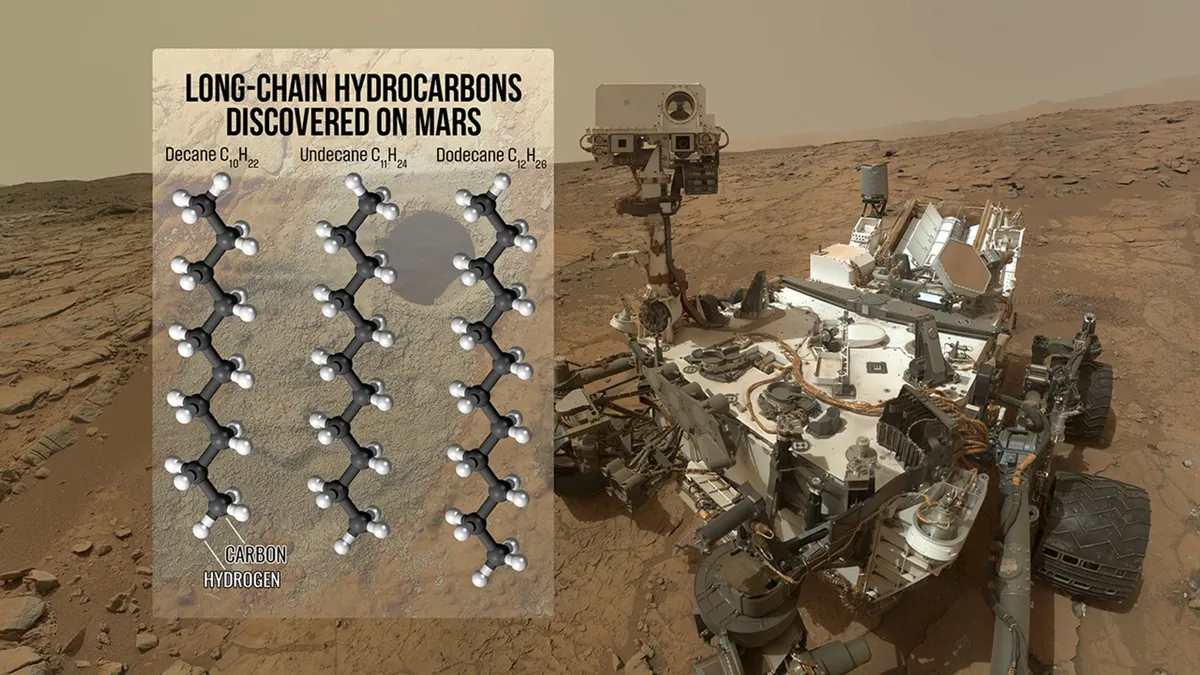NASA’s Curiosity rover has made a groundbreaking discovery on the Red Planet — the longest carbon chains ever detected on Mars. Found in a 3.7-billion-year-old rock sample from a dried lakebed in Gale Crater, these molecules may hold vital clues to ancient Martian life.
A Stunning Find in Yellowknife Bay
The molecules, strings of carbon atoms containing 10 to 12 links (known as decane, undecane, and dodecane), were uncovered in a sample from Yellowknife Bay — an area previously identified as a clay-rich, potentially life-supporting environment. This sample, affectionately dubbed “Cumberland,” was first drilled by Curiosity back in 2013.
Surprisingly, these hydrocarbon chains remained hidden for over a decade, only to be revealed accidentally during an experiment intended to search for amino acids — the building blocks of life. Scientists applied a new pre-heating method, reaching 1,100°C (2,012°F), which unexpectedly released the elusive molecules.
“New method, new results,” said co-author Caroline Freissinet, expressing her excitement over the unexpected peaks in the sample analysis.
What Do These Molecules Mean?
On Earth, long carbon chains like these are typically derived from fatty acids, which are essential components of biological membranes. While fatty acids can form through non-biological processes, chains with more than 12 carbon atoms are almost exclusively biological in origin.
The Martian molecules, researchers suggest, likely stem from fatty acids such as undecanoic and dodecanoic acids — compounds that break down into the carbon chains now detected. In lab simulations, similar breakdown patterns confirmed this possibility.
Could This Be Evidence of Ancient Life?
The discovery raises a profound question: Could these molecules be remnants of ancient Martian life? While the origin of the carbon chains is still uncertain, their preservation over billions of years in Mars’ harsh environment is promising for astrobiology.
“If life ever appeared on Mars billions of years ago, chemical traces of this ancient life could still be present today for us to detect,” Freissinet told Live Science.
The conditions within Gale Crater, including its ancient lakebed and the long-standing presence of liquid water, make it a prime candidate for life-forming chemistry. This discovery proves that Curiosity’s onboard instruments can identify complex organic molecules — even if they're buried deep in time.
What’s Next for Mars Exploration?
This accidental but vital discovery comes at a pivotal time, as NASA and other space agencies plan future missions to bring Martian soil samples back to Earth. With advanced lab techniques, scientists hope to further explore the origins of these carbon chains and, potentially, resolve the age-old mystery: Was there ever life on Mars?
“We are ready to take the next big step and bring Mars samples home to our labs to settle the debate about life on Mars,” said NASA researcher Daniel Glavin.
Final Thoughts
The Curiosity rover’s latest find adds another chapter to our understanding of Mars’ past. While not definitive proof of life, the discovery of these long carbon chains opens the door to new possibilities — and fuels hope that the Red Planet may have once been alive.
What do you think? Could this be the strongest hint of Martian life yet? Share your thoughts below!




Post a Comment
0Comments